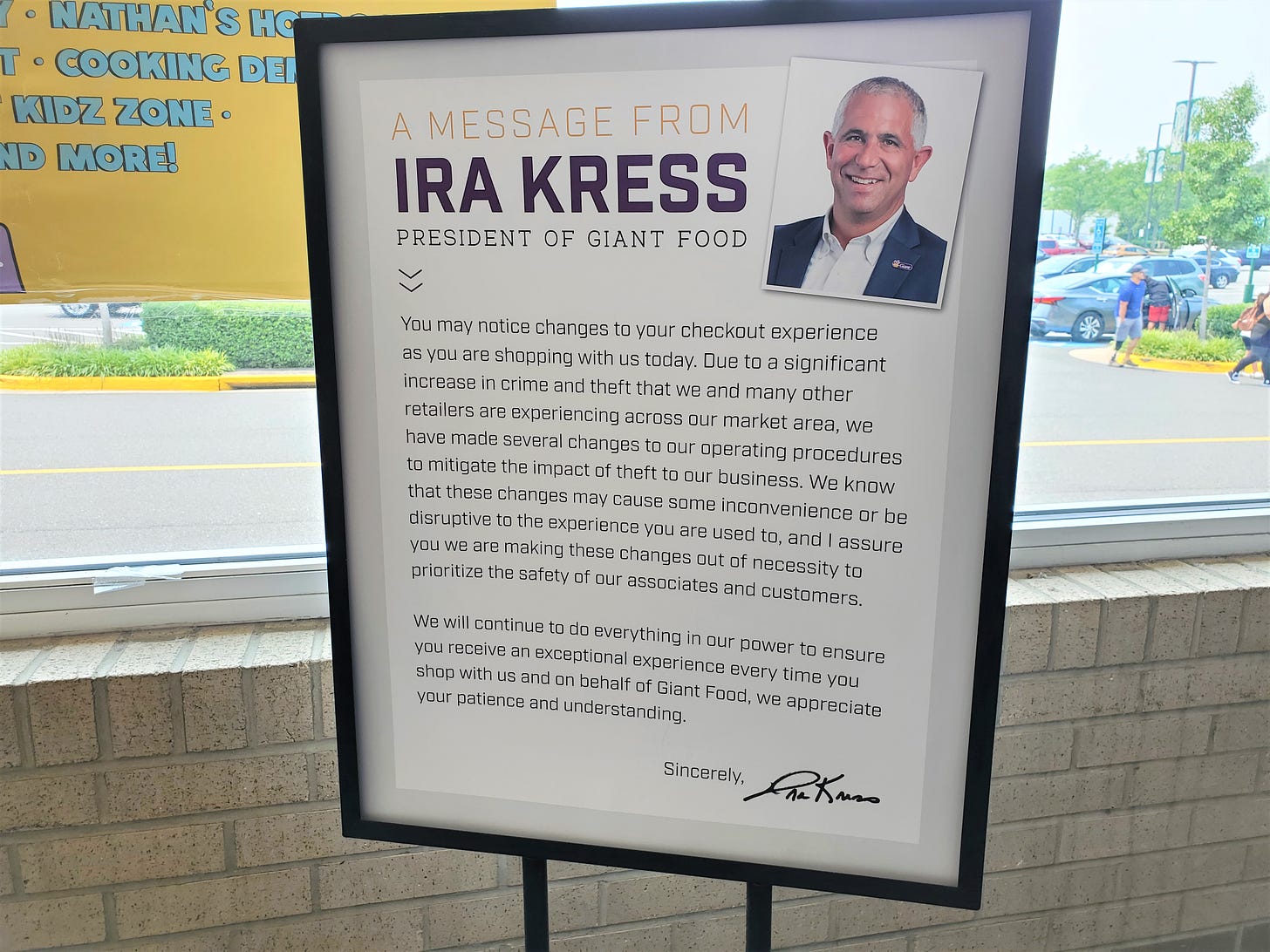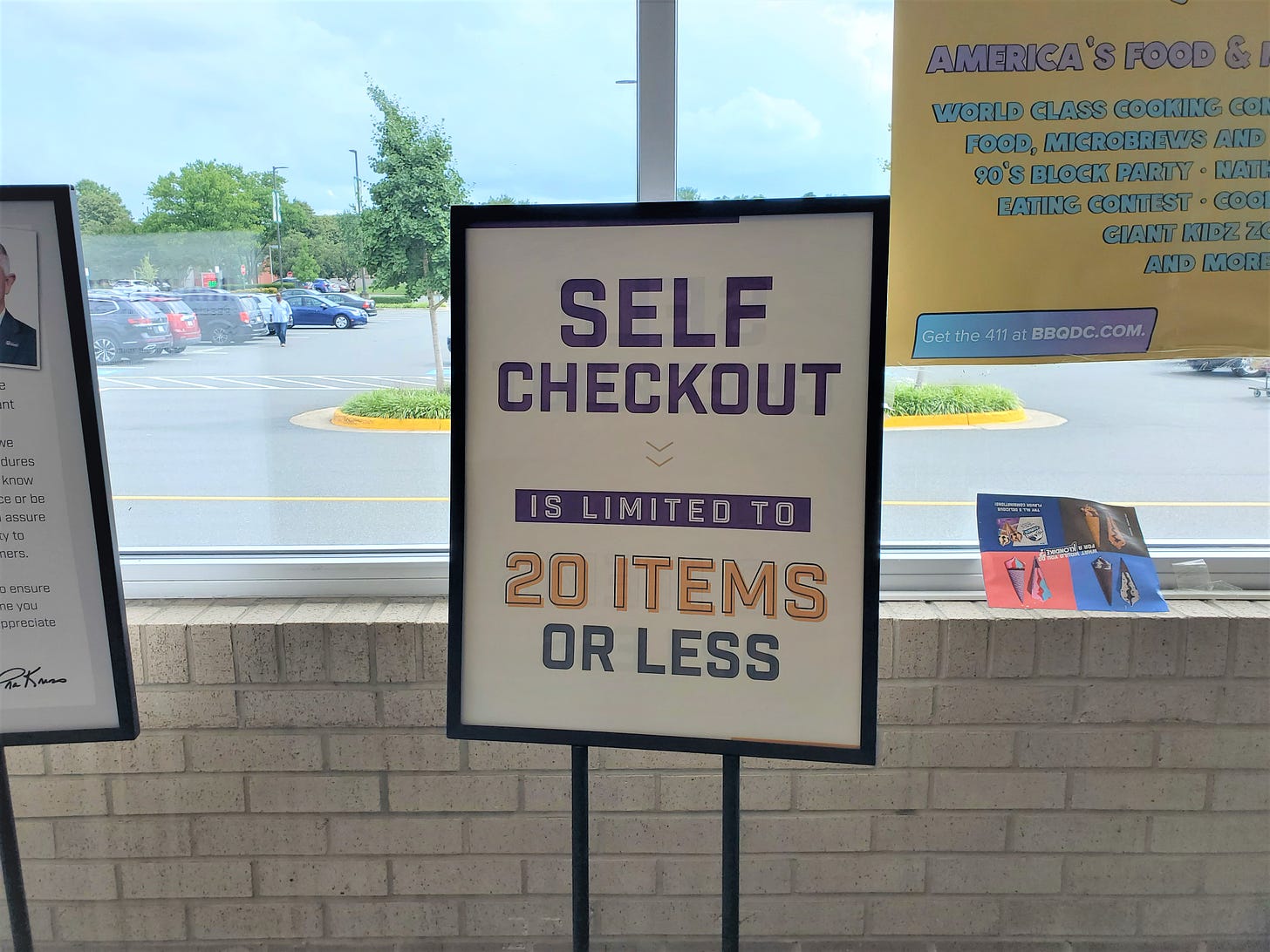Our new house is a very short drive, or a short walk, from a Giant supermarket—one of the major supermarket chains in the Mid-Atlantic. (They’re quasi-related to Martin’s and Stop & Shop, as well as a different Giant based in Pennsylvania—that bit of corporate intrigue might be another piece here!)
I like walking there for small shopping trips, or just looking around, since it’s on one of my walking routes anyway. But lately, I’ve been less keen on shopping there. And to tell you the truth, I’m about ready to boycott Giant, or at least this location.
Recently—in response to vaguely cited concerns over shoplifting and other unspecified crime—the store has tightened the screws and made the customer experience worse for everyone.
Here’s the euphemistic message from the company president that’s been placed in the store lobby:
First of all, since the message is generic, this is not a reference to any particular occurrences in a pretty nice supermarket at the suburban western edge of Fairfax County, in one of the area’s most desirable neighborhoods. There are some localities where stores really have seen spikes in retail theft and even robbery or violent crime. I’m not so sure this is one of them.
What “changes to your checkout experience” are we talking about, anyway?
Here’s one, also in the lobby:
There might be one or two checkout aisles open; the rest sit there empty, creating dead space in the store. But the spaces between them are roped off so no one can get from the exit area to the store through them. An ugly kludge of a solution.
I haven’t tested whether the self-checkout machine actually refuses to ring up a 21st item; I doubt it’s that sophisticated. It’s probably more like getting carded; if the self-checkout employee on duty decides you look like you have too many items, maybe you’ll be asked to check out with a (the) cashier. Or maybe nothing ever happens, and it’s just supposed to make you a little apprehensive. Well, it works.
But here’s the meat of it:
This is very detailed—no, make that complicated—and the first prompt has never been given to me by the machine. What it really means is that just about the second you scan an item, the machine prompts you to place it in the bagging area. It will do this again and again, and if within maybe five seconds you haven’t placed it there, it locks up and forces you to call an employee over. Sometimes it unlocks itself just as they arrive.
This set of rules has only aggravated all of the familiar problems with these finnicky machines, which are programmed to both work and suppress shoplifting, which means that they frequently do neither. Once, I placed my hat in the bagging area while I rang up, which locked the machine (unscanned item in bagging area, please wait for assistance.) Another time I bought a single tiny habanero pepper—it came to about five cents—which I dutifully scanned and placed in the bagging area. But it was so light, the scale didn’t even detect it. Item not placed in bagging area, please wait for assistance.
Maybe I should’ve just stolen the damn pepper.
The changes in the store go beyond just the worsening of the self-checkout experience. One of the store’s two exits has been blocked off and turned into an informal emergency exit—apparently this is sometimes done to reduce alcohol shoplifting; the exit closest to the wine and beer section is the one that’s usually closed, which is the case here.
It’s done in a way that obviously goes against the intended design of the store:
From my vantage point, the macgyvered appearance of all of this makes shoplifting more inviting, not less. And it makes the store, for a law-abiding customer, less inviting, not more.
It’s really the bigger picture that irks me here. There’s an obvious fix for this overall problem of people walking out of stores with stuff: rip out the self-checkouts, put people back in the checkstands, and allow normal human interaction to create incentives for better behavior.
Look, in some rough neighborhoods employees might get personally attacked or asked to empty the cash register at gunpoint. When actual danger is involved, do what you have to do. But that’s not the sort of problem stores are complaining about, and it’s certainly not the problem in this one. It’s mostly shoplifting. And when you have to ring up with an actual person, shoplifting is much more challenging.
When one employee is semi-watching a bank of 8 or 10 self-checkout machines, an experienced shoplifter won’t have much trouble. Key in the wrong codes; hold two items and ring up only one; leave some stuff in the basket, add the stuff you did ring up, and walk out confidently.
But wait—some stores now police taking baskets out of the checkout area; apparently, following bag bans, pilfering and keeping shopping baskets has become popular. In that case, treat your reusable bag as a shopping basket and dare the overworked employee to inspect your bag.
Whatever; I’m not giving advice and I’m not speaking from experience. But it’s obvious that automated checkout is much easier to cheat than human cashiers. And frankly, when you take out the human interaction, it starts to feel like a challenge or a game. You feel like you’re playing the computer. And what’s so bad about stealing from a computer?
This is as fine an example as any of a convenience eventually turning into a shackle. Does it really save the company money to pay fewer people, see a spike in shoplifting, make the automated system even worse, and chase away the customers who do actually pay for everything? What about customer service? What about pride in excellence?
In cutting their staff and turning their stores into unpoliced warehouses of loot, stores were being pennywise and pound foolish. They turned on the stove and wondered why the pot boiled. And now, having shot themselves in the foot, they’re trying to stick the customers with the medical bill.
“We will continue to do everything in our power to ensure you receive an exceptional experience every time you shop with us,” the president writes in that missive. It’s not a restaurant, but I’ll go with a Gordon Ramsay line: Exceptional. Exceptionally poor.”
Giant will do “everything in its power”—except ripping out the machines and putting real people in the store again. And they’ll blame “crime” instead of themselves.
Not too far away, there’s a big supermarket with better prices, more stuff, two big open entrances, plenty of cashiers and self-checkouts, and no subtle diminishments of the customer experience. They’re not paying me to write this (I wish); they’re just better.
Talk all you want about “exceptional,” buddy. I’m putting customer service over walkability, and I’m driving to Wegmans.
Related Reading:
Thank you for reading! Please consider upgrading to a paid subscription to help support this newsletter. You’ll get a weekly subscribers-only post, plus full access to the archive: over 700 posts and growing. And you’ll help ensure more material like this!









Giant used to be one of the best places to work. Back in the 90s they paid far above minimum wage ($20/hr or more) and I know a few friends that literally put themselves through college by working there. In the 2000s I worked at the Food Marketing Institute and our clients were supermarket retailers and wholesalers. I primarily worked with the international companies.; like Ahold, Giant's corporate parent. 20 years ago, when they started rolling out the self-checkout, they touted this as great for the company and increasing profits because you could hire more employees to improve the customer experience. Contrary to popular belief supermarkets operate on tiny margins (similar to restaurants) and Wal-Mart essentially wiped-out entire grocery chains one by one starting in the late 90s. A lot of local and regional family-run businesses essentially died overnight. When the scanners were introduced, there was a flood of kickback from customers because nobody wanted to ring up their own groceries and basically teach ourselves how to use a company register; especially if they're dealing with tantrummy kids. There was also the concern that this would tantalize stores to hire less people - not more. We dealt with all of these issues at our regional and annual conferences with the result being add more self-checkout...not less. Well, here we are. The only company that seems to be addressing this well is Wegmans. Incidentally Danny Wegman was our board chairman when I first started my employment far before Wegmans was even in the DMV. Go to any Wegmans and not only do they have about 15 self-checkout aisles (with an employee staffed at each one), but they still have about 20 fully staffed registers. AND they pay their employees competitive wages. I've noticed that Costco is also doing a pretty good job at balancing both. Essentially my reply to that sign at Giant is a) it's your own damn fault, and b) quit treating all of your customers like thieves. There are other retail options and eventually your customers are going to find their own way out the door.
The person working in the self checkout will send you to the check out line if they think you have more than 20 items. When I told her I counted as I shopped so I knew there were only 18, she said I have a lot of grapes so it must be more than 20. I picked up my purse and reusable bag and walked out. I understand that they have to do something to limit shoplifting but that was ridiculous.